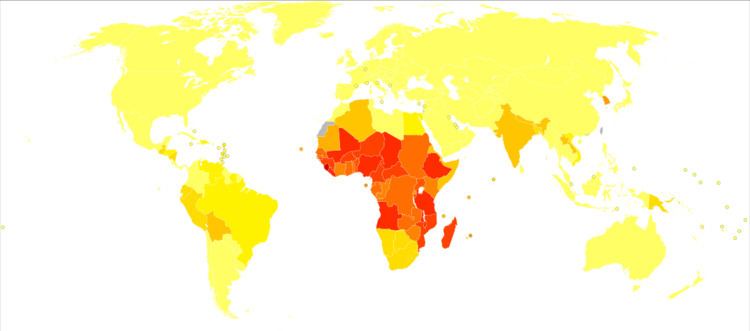 | ||
Tropical diseases are diseases that are prevalent in or unique to tropical and subtropical regions. The diseases are less prevalent in temperate climates, due in part to the occurrence of a cold season, which controls the insect population by forcing hibernation. However, many were present in northern Europe and northern America in the 17th and 18th centuries before modern understanding of disease causation. The initial impetus for tropical medicine was to protect the health of colonialists, notably in India under the British Raj. Insects such as mosquitoes and flies are by far the most common disease carrier, or vector. These insects may carry a parasite, bacterium or virus that is infectious to humans and animals. Most often disease is transmitted by an insect "bite", which causes transmission of the infectious agent through subcutaneous blood exchange. Vaccines are not available for most of the diseases listed here, and many do not have cures.
Contents
- Special Programme for Research and Training in Tropical Diseases TDR
- Other neglected tropical diseases
- Relation of climate to tropical diseases
- Prevention and treatment of tropical diseases
- References
Human exploration of tropical rainforests, deforestation, rising immigration and increased international air travel and other tourism to tropical regions has led to an increased incidence of such diseases.
Special Programme for Research and Training in Tropical Diseases (TDR)
In 1975 the Special Programme for Research and Training in Tropical Diseases (TDR) was established to focus on neglected infectious diseases which disproportionately affect poor and marginalized populations in developing regions of Africa, Asia, Central America and South America. It was established at the World Health Organization, which is the executing agency, and is co-sponsored by the United Nations Children's Fund, United Nations Development Programme, the World Bank and the World Health Organization.
TDR's vision is to foster an effective global research effort on infectious diseases of poverty in which disease endemic countries play a pivotal role. It has a dual mission of developing new tools and strategies against these diseases, and to develop the research and leadership capacity in the countries where the diseases occur. The TDR secretariat is based in Geneva, Switzerland, but the work is conducted throughout the world through many partners and funded grants.
Some examples of work include helping to develop new treatments for diseases, such as ivermectin for onchocerciasis (river blindness); showing how packaging can improve use of artemesinin-combination treatment (ACT) for malaria; demonstrating the effectiveness of bednets to prevent mosquito bites and malaria; and documenting how community-based and community-led programmes increases distribution of multiple treatments. TDR history
The current TDR disease portfolio includes the following entries:
Other neglected tropical diseases
Additional neglected tropical diseases include:
Some tropical diseases are very rare, but may occur in sudden epidemics, such as the Ebola hemorrhagic fever, Lassa fever and the Marburg virus. There are hundreds of different tropical diseases which are less known or rarer, but that, nonetheless, have importance for public health.
Relation of climate to tropical diseases
The so-called "exotic" diseases in the tropics have long been noted both by travelers, explorers, etc., as well as by physicians. One obvious reason is that the hot climate present during all the year and the larger volume of rains directly affect the formation of breeding grounds, the larger number and variety of natural reservoirs and animal diseases that can be transmitted to humans (zoonosis), the largest number of possible insect vectors of diseases. It is possible also that higher temperatures may favor the replication of pathogenic agents both inside and outside biological organisms. Socio-economic factors may be also in operation, since most of the poorest nations of the world are in the tropics. Tropical countries like Brazil, which have improved their socio-economic situation and invested in hygiene, public health and the combat of transmissible diseases have achieved dramatic results in relation to the elimination or decrease of many endemic tropical diseases in their territory.
Climate change, global warming caused by the greenhouse effect, and the resulting increase in global temperatures, are possibly causing tropical diseases and vectors to spread to higher altitudes in mountainous regions, and to higher latitudes that were previously spared, such as the Southern United States, the Mediterranean area, etc. For example, in the Monteverde cloud forest of Costa Rica, global warming enabled Chytridiomycosis, a tropical disease, to flourish and thus force into decline amphibian populations of the Monteverde Harlequin frog. Here, global warming raised the heights of orographic cloud formation, and thus produced cloud cover that would facilitate optimum growth conditions for the implicated pathogen, B. dendrobatidis.
Prevention and treatment of tropical diseases
Some of the strategies for controlling tropical diseases include:
